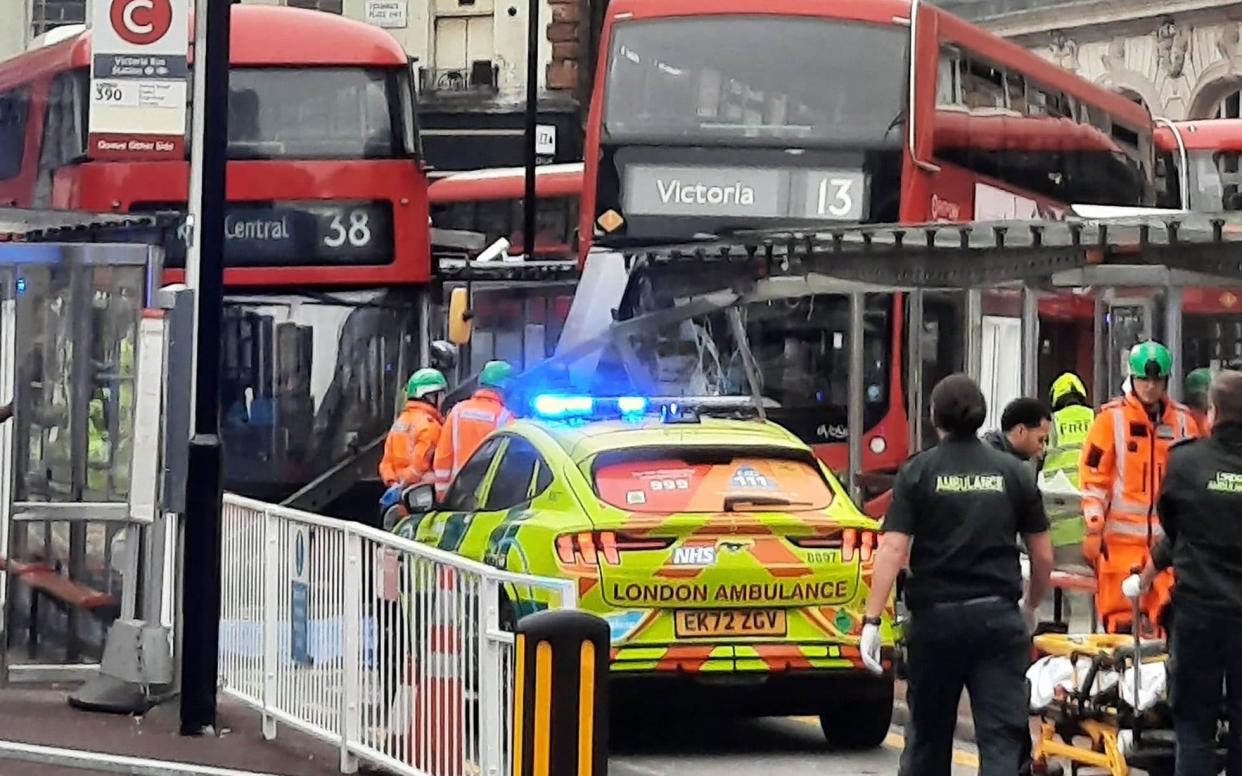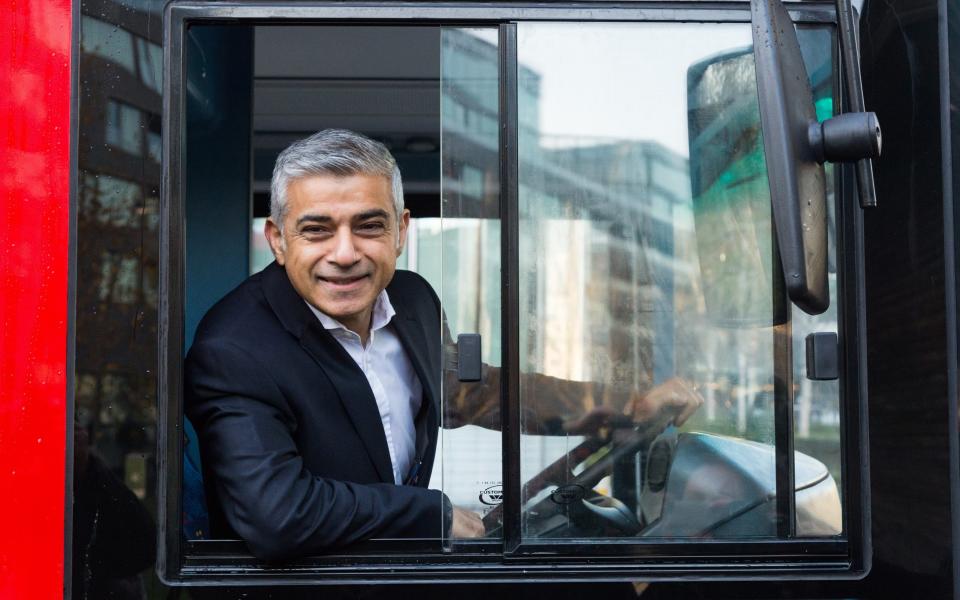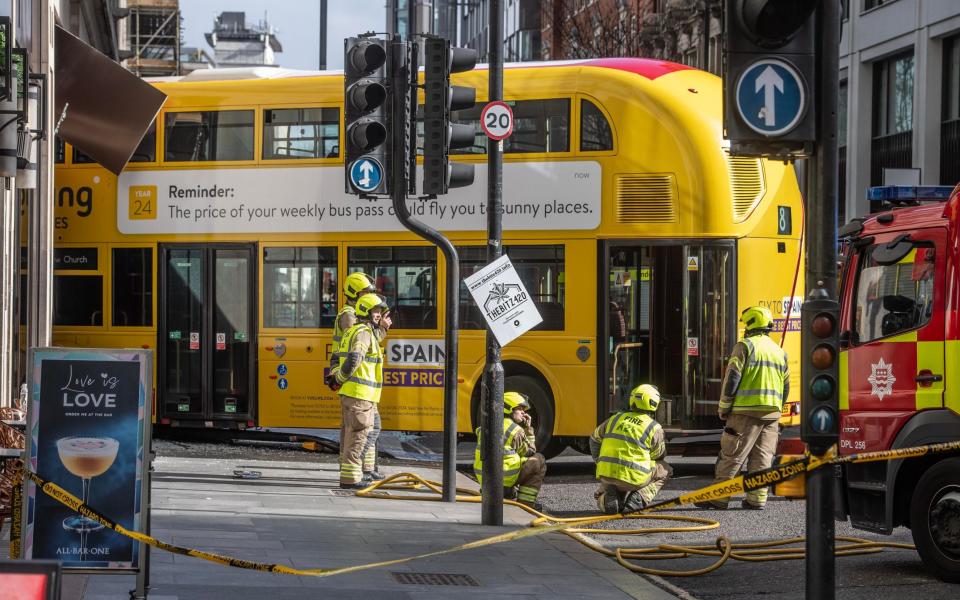London buses ‘more dangerous’ under Khan as critics claim 20mph pressures drivers to go faster

- Oops!Something went wrong.Please try again later.
London buses are getting “more dangerous” under Sadiq Khan’s premiership, public transport experts and campaigners have claimed.
Collisions are higher on average than they were between 2014 and 2023 because new low speed limits put pressure on drivers to go faster when they can in order to keep up with their schedule, critics have argued.
Official figures show that the distance covered by London buses has gone down since the pandemic but the number of collisions has increased, meaning buses are injuring more people per mile travelled.
Between 2014 and 2023, London averaged 26,384 bus collisions per year, according to an analysis of TfL figures. In 2023, that number rose to 28,114 despite buses making fewer journeys.
In the financial year 2016 to 2017, London buses were operated over a total distance of 492 million kilometres, according to TfL data. Between 2022 and 2023, it was 457 million kilometres: a decrease of 7 per cent.
Critics of the Mayor put the higher collision rates down to the fact that new 20mph speed limits make it harder for bus drivers to meet their schedule without driving fast on the roads when they can.

A training document from 2016 given to bus drivers by Go Ahead, TfL’s largest bus contractor, said: “We must try and keep this gap [between buses] as even and as close to what is scheduled as possible. If we fail, we can be fined up to 10 per cent of the contract price.”
Neil Garratt, leader of the City Hall Conservatives, said that lower speed limits on busier roads mean that bus drivers feel pressure to go faster on other roads to keep up with the timetable – which he said hasn’t been factored into the new speed limits introduced under Mr Khan.
Mr Garratt said: “Drivers feel caught in a pincer movement between lowered speed limits on busier roads and a relentless timetable pressure. I think the Mayor is in denial about the safety implications of heaping so much pressure on people doing an already challenging, stressful job.
“Despite his many promises and strategy documents, the stark fact is that London’s buses are getting more dangerous under Mayor Khan.”
The findings cast doubt over Mr Khan’s “Vision Zero” programme, launched in 2018, which looked to eliminate deaths caused by buses by 2030.

Michael Liebreich, who oversaw health and safety while sitting on TfL’s board between 2012 and 2018, said: “It’s becoming more and more difficult to meet the schedule. So the pressure on drivers is only increasing.”
Mr Liebreich also said that London was in the lowest quartile of cities – ranked by vehicle collisions – in a 2021 study done by the International Bus Benchmarking Group.
Now working as a transport executive, Mr Liebreich said: “People should be scared. We have a really unsafe system in London. There are hundreds of victims here.”
Since 2016, 61 people have been killed in bus collisions, TfL data shows.
Chronic fatigue
Some bus drivers on particular routes are also alleged to be speeding, yet TfL admitted it does not routinely share this information with the police, Questions to the Mayor shows.
In January 2020, Unite said bus drivers were also suffering from “chronic fatigue” after a survey found 36 per cent of drivers had had a “close call” because of tiredness in the past 12 months.
A spokesperson for the Mayor of London, said: “The Mayor is committed to ensuring London’s transport network and roads are as safe as possible. Since introducing his goal to eliminate road deaths in London, both deaths and serious injuries in London have fallen faster than the national average.
“Buses are already the safest way to travel on London’s roads and carry more people than any other public transport mode. Despite the Government trying to force major bus cuts in London, the Mayor has managed to protect the vast majority of bus routes and is now expanding bus services, particularly in outer London. This includes the new Superloop bus network.
“In September, TfL announced a new strategy to make buses even safer. This includes continuing to roll-out the world-leading Bus Safety Standard, which specifies safety standards for new buses in London. More than 1,400 buses now meet the standard and this number will increase as older vehicles are replaced with new electric buses. The Mayor has pledged to make all of the capital’s buses zero-emission by 2030.”
TfL and Go Ahead declined to comment.

